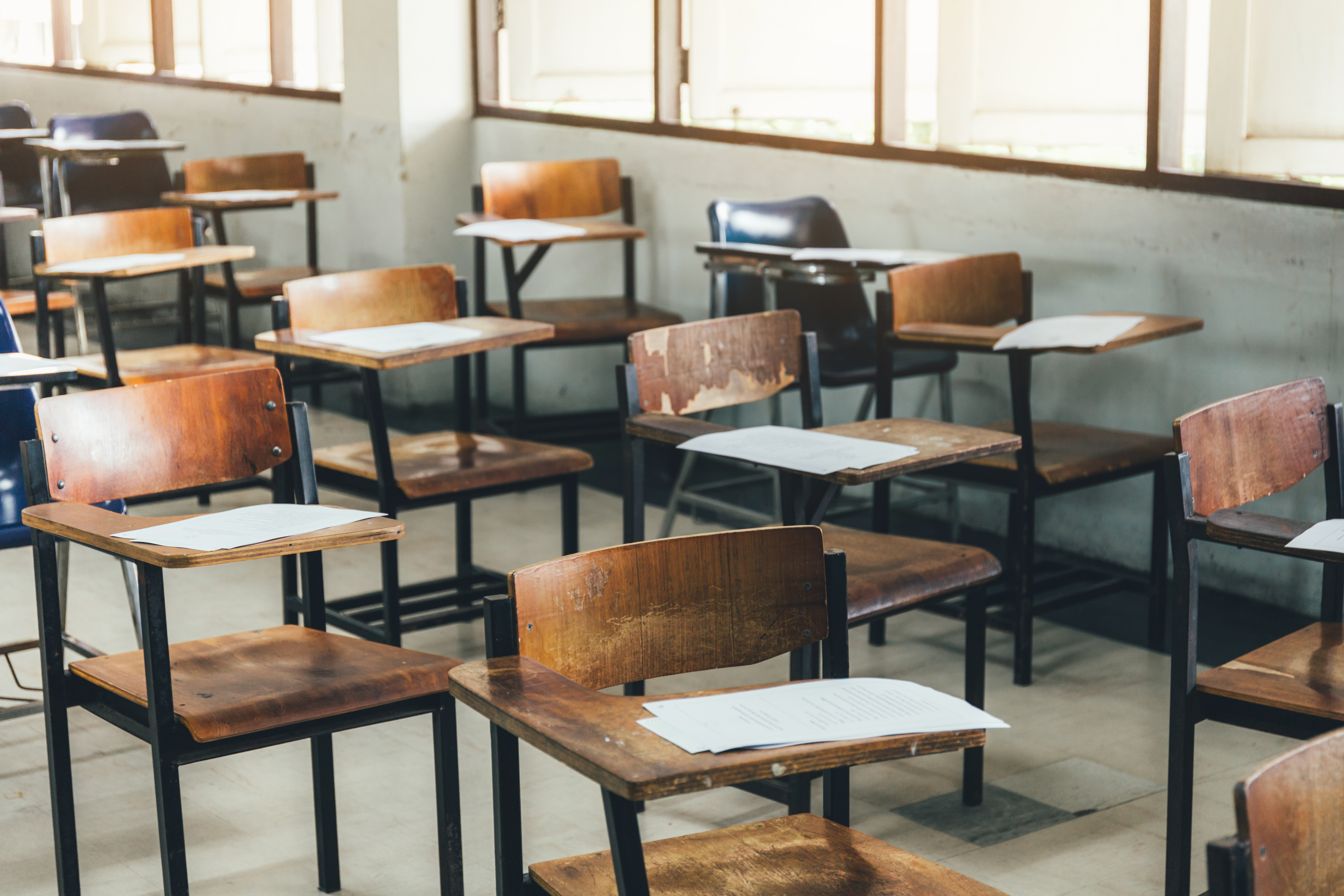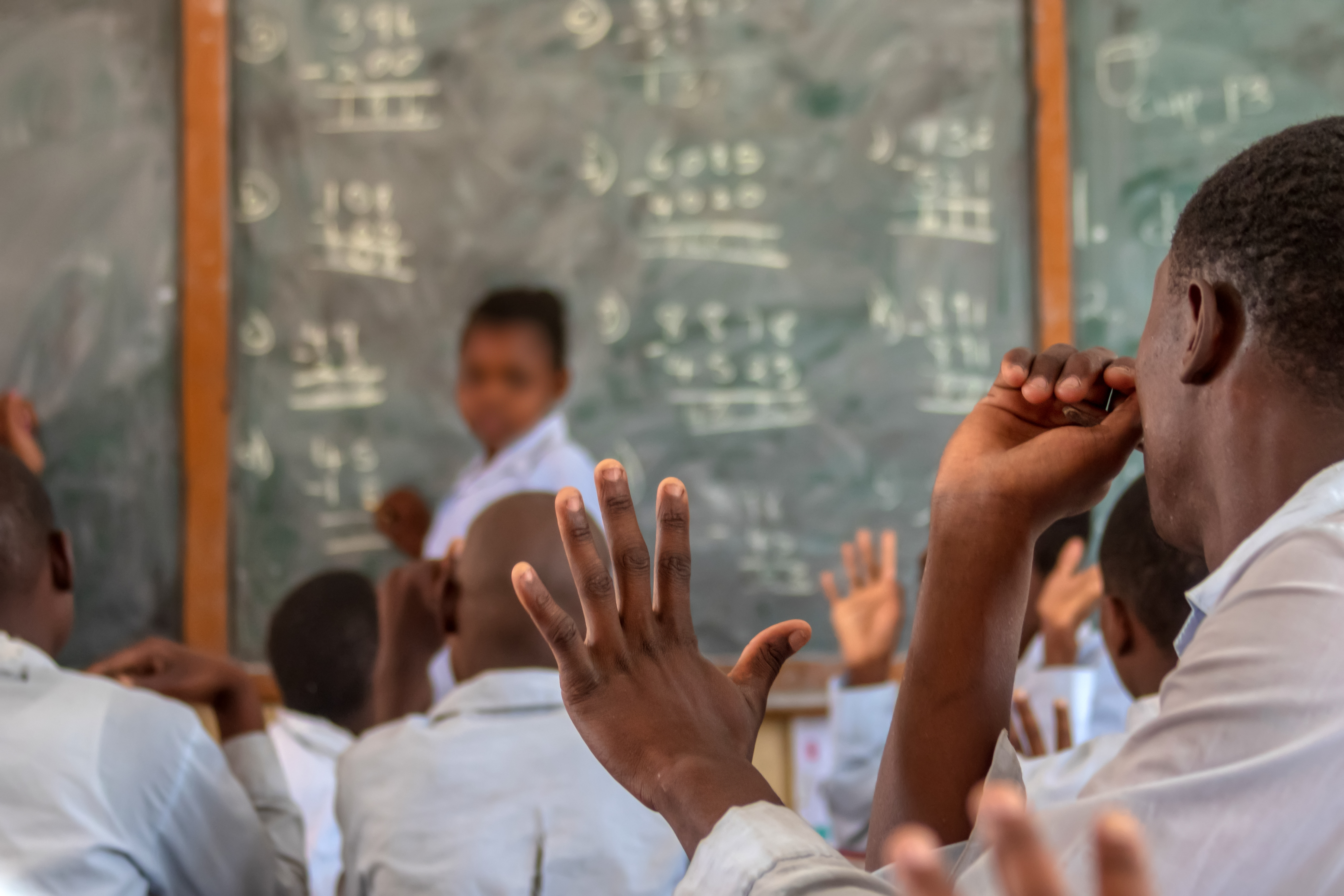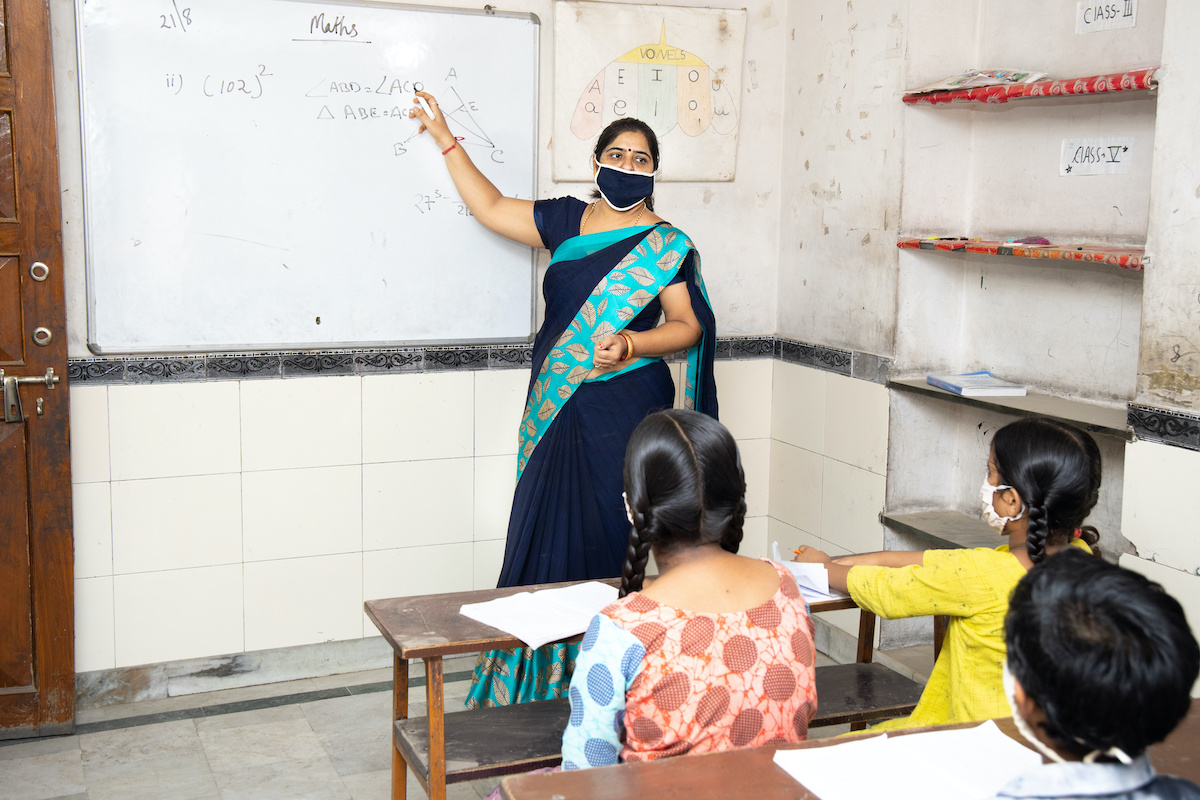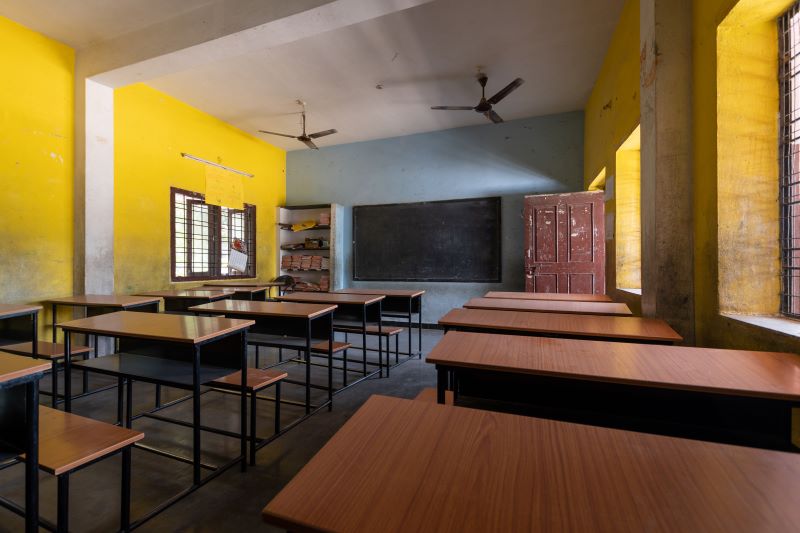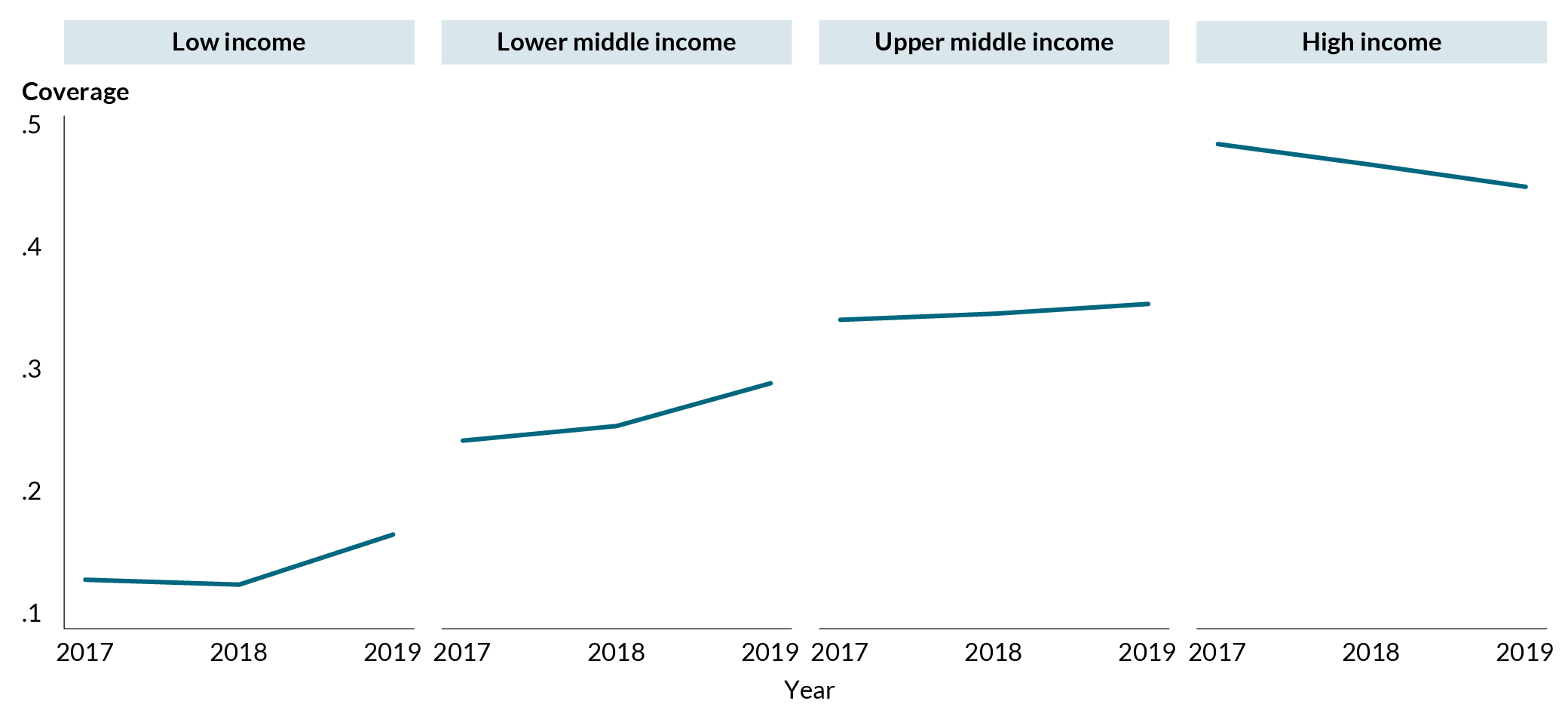Note: This blog post is part of a series in which CGD experts present arguments from “Schooling for All: Feasible Strategies to Achieve Universal Education” and invite (sometimes dissenting) commentary from experts within the global education community.
Biniam Bedasso: “Feeding kids may look expensive by standard value-for-money metrics, but it promotes equity in outcomes beyond just test scores.”
The central appeal of school feeding is that it allows policymakers to target multiple objectives with a relatively straightforward and scalable intervention delivered on school premises. A review of 11 experimental and quasi-experimental studies from low- and middle-income countries reveals that school feeding contributes to better learning outcomes at the same time as it keeps vulnerable children in school and improves gender equity in education. Although school feeding might appear cost-ineffective compared with specialized education or social protection interventions, the economies of scope it generates are likely to make it a worthwhile investment particularly in food-insecure areas. Given the existing gap in coverage in low-income countries, financing might be a key constraint in the very places where school feeding tends to have the largest marginal returns.
Median spending [on school meals] among low-income countries is 0.7 percent of education expenditure, whereas the corresponding figure for high-income countries is 2 percent.
Figure 1. Trends in the coverage of school feeding across countries in various income groups
Source: Author's computation based on GCNF (2019)
Read Biniam Bedasso’s full chapter here.
Farzana Afridi: “Multifaceted benefits make school meals cost-effective, but more evidence is needed on long-term gains”
“Historically, the immediate objective of school meal programs has been to improve child nutrition and health. This holds for both poor as well as higher-income countries. However, it is imperative to understand how and whether such programs can affect learning, since educational attainment has longer-term implications for labor market outcomes of children as they transition to adulthood.”
[...]
“In terms of cost–benefit estimates, it would also be worthwhile to compare school meals with other interventions to improve learning outcomes in developing countries—school inputs, teacher incentives, remedial education, and more recently, EdTech (see Holla and Kremer 2009 for a review). However, the paucity of rigorous and more contextualized estimates of long-term benefits of school meals for comparison with other school-based interventions poses a challenge.”
Read Afridi’s full comment.
Comment: Multifaceted benefits make school meals cost-effective, but more evidence is needed on long-term gains
Historically, the immediate objective of school meal programs has been to improve child nutrition and health. This holds for both poor as well as higher-income countries. However, it is imperative to understand how and whether such programs can affect learning, since educational attainment has longer-term implications for labor market outcomes of children as they transition to adulthood.
To put the review’s overarching objective in perspective, it would be worthwhile to first outline the pathways through which school meals can improve learning outcomes:
Direct impact: First, as a conditional transfer program, school meals can improve school participation (both enrollment and regular attendance), particularly of children in poor households and girls. Coming to school regularly may itself increase learning, conditional on some minimum quality of teaching. Second, school meal programs directly impact child nutrition through potentially higher nutrient consumption in low-income settings. Research shows that households are not purely altruistic in making resource allocation decisions, and hence targeted transfers such as school meals have a significantly higher marginal impact on children’s daily nutrition than transfers to households (e.g., Afridi 2010 on India; Jacoby 2002 on the Philippines; Kooreman 2000 on the labeling effect of targeted transfers). This can have an impact on child cognition, especially when malnourishment is widespread and school meals are also fortified with nutrients to address micronutrient deficiency, such as anemia, which is often prevalent in low-income countries (Berry et al. 2020). Both school participation and nutritional improvements have short- and long-term implications on learning.
In the short term, meals provided during school hours can improve classroom attention, by reducing classroom hunger (Afridi, Barooah, and Somanathan 2019 on India). This was the rationale for introducing the breakfast program in the United States (Bhattacharya, Currie, and Haider 2006), but it is also relevant in poor and middle-income countries. Indeed, there is credible and strong evidence, from multiple contexts, of the positive effects of school meals on children’s school participation, nutrition, and health. Surprisingly, while these first-order effects have been studied intensely, there is much, much less evidence on the short- and long-term learning impacts.
Indirect impact through externalities or spillover effects: Provision of school meals is a conditional, in-kind transfer program that reduces food insecurity in agrarian and poor economies (Singh, Park, and Dercon 2014 on India). Hence, the potential income effect on beneficiary households can also impact the educational outcomes of the child. Second, provision of school meals can also reduce disruptive behavior of peers who often come to school on empty stomachs, and have spillover effects, generating externalities that would suggest existing estimated impacts on classroom learning could be downward biased (e.g., see Kremer and Miguel 2004 on deworming in Kenya).
While there is evidence on reduction in food insecurity and household consumption smoothing, there has not been any research on spillover impacts within the classroom.
Overall, as the review article points out, direct evidence, on both short- and long-term learning outcomes, is surprisingly limited. This is particularly disappointing when it comes to large-scale, nationwide programs, such as India’s school feeding program (except Chakraborty and Jayaraman 2019), which is the largest in the world and exists within a public education system that is well known to exhibit poor learning outcomes (ASER Centre 2018).
Based on the limited evidence on the effects of school meals on learning outcomes, the review article provides some estimates of the improvements in learning outcomes. While many of these estimates are also short term and primarily based on small-scale randomized control trials (RCTs), it is nevertheless instructive to point out the cost-effectiveness of school meals from a policy perspective. The review article highlights the cost-effectiveness of school meals, particularly when we account for its multidimensional impact on child outcomes and in the labor market in adulthood. It would be useful to also have more information on how learning outcomes were measured in these studies, in the context of either limited data availability or education systems that are incentivized to teach to the test (see World Bank 2019).
In terms of cost–benefit estimates, it would also be worthwhile to compare school meals with other interventions to improve learning outcomes in developing countries—school inputs, teacher incentives, remedial education, and more recently, EdTech (see Holla and Kremer 2009 for a review). However, the paucity of rigorous and more contextualized estimates of long-term benefits of school meals for comparison with other school-based interventions poses a challenge.
The review briefly touches upon the challenge of monitoring and scaling of school meals. This is of particular relevance in the low-state-capacity context of most developing countries, which also have greater need for an effective school meal program. Here it is relevant to mention that variation in the design of the program not only has implications for its impact but also on monitoring and leakages. For instance, India’s school meal program transitioned from take-home rations once a month to daily provision of cooked meals during school days. Since the conditionality is weaker in the former than in the latter, evidence suggests that provision of cooked meals was more effective in improving both nutrition and school participation. At the same time, leakages are likely to be lower in the latter case. Increasingly, IT tools are being adopted to monitor the program (Debnath, Niayamgode, and Seekhri 2020), and more evidence on this issue is required.
To summarize, the review article is a timely reminder of the multifaceted benefits and high cost effectiveness of this targeted, conditional transfer program. One hopes that it brings greater attention to the need for more rigorous evidence on the program’s learning effects in the longer term in low-income settings that go beyond small-scale RCTs and are instead based on at-scale, credible, standardized test scores and labor market returns data.
References
Afridi, F. 2010. “Child Welfare Programs and Child Nutrition: Evidence from a Mandated School Meal Program in India.” Journal of Development Economics 92: 152–65.
Afridi, F., B. Barooah, and R. Somanathan. 2019. Hunger and Performance in the Classroom. IZA Discussion Paper 12627.
ASER Centre. 2018. “Main Findings: All India (Rural) Report.” Annual Status of Education Report 2018. New Delhi. https://img.asercentre.org/docs/ASER%202018/Release%20Material/aser2018nationalfindingsppt.pdf.
Berry, J., S. Mehta, P. Mukherjee, H. Ruebeck, and G. K. Shastry. 2020. “Implementation and Effects of India’s National School-Based Iron Supplementation Program.” Journal of Development Economics 144 (C).
Bhattacharya, J., J. Currie, and S. J. Haider. 2006. “Breakfast of Champions? The School Breakfast Program and the Nutrition of Children and Families.” Journal of Human Resources 41 (3): 445–66.
Chakraborty, T., and R. Jayaraman. 2019. “School Feeding and Learning Achievement: Evidence from India’s Midday Meal Program.” Journal of Development Economics, 139.
Debnath, S., M. Niayamgode, and S. Seekhri. 2020. “Information Bypass: Using Low-Cost Technological Innovations to Curb Leakages in Welfare Programs.” Working paper, University of Virginia.
Holla, A., and M. Kremer. 2009. “Improving Education in the Developing World: What Have We Learned from Randomized Evaluations?” In Annual Review of Economics, vol. 1, edited by K. J. Arrow and T. F. Bresnahan, 513–42.
Jacoby, H. G. 2002. “Is There an Intrahousehold Flypaper Effect? Evidence from a School Feeding Program.” Economic Journal 112 (476): 196–221.
Kooreman, P. 2000. “The Labeling Effect of a Child Benefit System.” American Economic Review 90 (3): 571–83.
Kremer, M., and E. Miguel. 2004. “Worms: Identifying Impacts on Education and Health in the Presence of Treatment Externalities.” Econometrica 72: 159–217.
Singh, A., A. Park, and S. Dercon. 2014. “School Meals as a Safety Net: An Evaluation of the Midday Meals Scheme in India.” Economic Development and Cultural Change 62 (2): 275–306. https://www.jstor.org/stable/10.1086/674097.
World Bank. 2019. “Learning Assessment Platform (LeAP).” Brief, July 12. https://www.worldbank.org/en/topic/education/brief/learning-assessment-platform-leap
Ugo Gentilini and Shwetlena Sabarwal: “School meals bring social protection and education to the table”
“[S]chool feeding makes political sense. The nature of school meals evokes goals and beneficiaries—children, their nourishment, and schooling—that garner broad support among the public and across the political aisle. As Biniam Bedasso suggests, programs that provide food to children who may otherwise go hungry have an inherent moral appeal.
“It is possibly for this reason that school feeding programs have a rich and deep history, in some cases dating back to the 18th century, and enjoy a large operational footprint. In fact, school feeding schemes are among the largest-coverage social protection programs, and among the top performers in reaching the most people (World Bank 2018). Such a powerful combination of noble objectives, tradition, and scale make school feeding programs a natural embodiment of society’s social contracts.”
Read Gentili and Sabarwal’s full comment.
Comment: School meals bring social protection and education to the table
Social protection tends to attract passionate and heated debates worldwide. This is because the theme is a proxy for larger societal quandaries, such as how much redistribution is acceptable, who deserves it, and what forms it should take. And yet, school feeding programs tend to emerge relatively unscathed from these bitterly contested ideas.
Why? Various reasons are at play: to begin with, school feeding makes political sense. The nature of school meals evokes goals and beneficiaries—children, their nourishment, and schooling—that garner broad support among the public and across the political aisle. As Biniam Bedasso suggests, programs that provide food to children who may otherwise go hungry have an inherent moral appeal.
It is possibly for this reason that school feeding programs have a rich and deep history, in some cases dating back to the 18th century, and enjoy a large operational footprint. In fact, school feeding schemes are among the largest-coverage social protection programs, and among the top performers in reaching the most people (World Bank 2018). Such a powerful combination of noble objectives, tradition, and scale make school feeding programs a natural embodiment of society’s social contracts.
Finally, school feeding has been subject to extensive empirical scrutiny across an array of social and economic dimensions. While cash transfers have been on the fast track of academic interest, high-quality research on school feeding has been a regular, if perhaps less “visible,” feature of social protection literature over the past two decades. Bedasso makes reference to a UNESCO synthesis of 20 evaluations.
Bedasso’s contribution provides an insightful, compact overview of those effects of school feeding as well as of key policy quandaries. His chapter illuminates a range of key choices and dilemmas that underpin school feeding programs across the country income spectrum. Within the overall discussion, four considerations stand out.
First, the strength of the evidence tends to move from “strong” for service utilization (e.g., school enrollment and attendance) to more mixed and limited for longer-term outcomes, such as learning. In fact, the chapter’s Figure 2.3 shows that for math scores, there is ample heterogeneity in the direction of results as well as an overall small effect in magnitude (effect sizes tend to revolve around zero). This may suggest that one of the chapter’s headline messages—“School feeding does not only keep children in school but also helps them learn better”—should be interpreted with a dose of caution and nuance.
Second, the chapter rightly underscores the need not just to evaluate school feeding in general but to do so in a comparative mode. In fact, on the whole, further research is needed to establish how much longer-term benefit school feeding has over other social safety nets (especially the easier-to-implement, more flexible, and more adaptive cash transfer programs). However, is that even the right lens to use? It can be argued that the benchmark used should be not just other demand-side social protection interventions like cash transfers, but the broader menu of supply-side measures. For instance, the work of the Global Education Evidence Advisory Panel (2020), Neelsen et al. (2021), Bergstrom and Ozler (2021), and Evans and Yuan (2019) points precisely to the need for widening the horizon of comparisons and adopting an outcome-oriented instead of a program-centric approach.
Third, there is a really fascinating discussion about what governments most value within school feeding programs. Implicit here is an interesting quandary—how to make programs that enhance welfare on multiple dimensions salient to ministries that care only about one dimension.
School feeding programs, if well designed and delivered, can improve both education and health outcomes. However, they may not be the most efficient at improving just one of these. A comparison of 150 education-focused interventions (Angrist et al. 2020) suggests that school feeding is relatively effective in improving Learning Adjusted Years of Schooling (Filmer et al. 2020), but with a high variance. However, there are other programs, such as information campaigns, Teaching at the Right Level, and structured pedagogy, that do better.
As Bedasso’s review shows, governments most value school-feeding programs for education objectives. So if an education ministry was identifying policies to improve learning and retention, school feeding programs may not be its first choice. This decision making does not take into account what Bedasso calls the “economies of scope” of school feeding. In other words, the decision to implement school feeding programs may rest with line ministries that may not have the incentives to factor in the synergistic relationship between childhood nutrition, health, and education.
Admittedly, given the popularity and political salience of school feeding programs, this is not much of a constraint overall. But it would be interesting to see how much of a constraint this is on their scale-up in fiscally constrained environments.
Finally, the COVID-19 crisis has highlighted the limits of scaling up programs tied to particular institutions—in this case schools—which can occur when those same institutions are severely affected (i.e., school closures). Such a constraint might have been particularly acute for logistics-intensive programs like in-kind transfers. As a result, at least 27 countries have opted to replace meals served at school with vouchers and cash transfers provided directly to children’s families (Gentilini et al. 2022). While such a switch has been temporary, it has also opened up new longer-term opportunities and challenges for connecting ministries of education with those of social protection (Waxman et al. 2021).
Ultimately, the discussion on school feeding mirrors broader themes in development economics. The contexts that need school feeding the most—the low-income, food-insecure contexts—are also the ones that can least afford and manage them.
School feeding programs are ingrained in the state–citizens social contract. They are well evaluated. And they offer an institutional platform for pursuing multiple goals and delivering different services. The social protection and education communities should look at school feeding as one of the key entry points for working even more and better together.
References
Angrist, N., D. K. Evans, D. Filmer, R. Glennerster, F. H. Rogers, and S. Sabarwal. 2020. How to Improve Education Outcomes Most Efficiently? Policy Research Working Paper 9450. Washington, DC: World Bank. https://documents1.worldbank.org/curated/en/801901603314530125/pdf/How-to-Improve-Education-Outcomes-Most-Efficiently-A-Comparison-of-150-Interventions-Using-the-New-Learning-Adjusted-Years-of-Schooling-Metric.pdf.
Bergstrom, K., and B. Ozler. 2021. Improving the Well-Being of Adolescent Girls in Developing Countries. Policy Research Working Paper 9827. Washington, DC: World Bank. https://openknowledge.worldbank.org/bitstream/handle/10986/36478/Improving-the-Well-Being-of-Adolescent-Girls-in-Developing-Countries.pdf?sequence=1&isAllowed=y.
Evans, D. K., and F. Yuan. 2019. What We Learn about Girls’ Education from Interventions That Do Not Focus on Girls. Policy Research Working Paper 8944. Washington, DC: World Bank. https://openknowledge.worldbank.org/bitstream/handle/10986/32128/WPS8944.pdf?sequence=4&isAllowed=y.
Filmer, D., H. Rogers, N. Angrist, and S. Sabarwal. 2020. “Learning-Adjusted Years of Schooling (LAYS): Defining a New Macro Measure of Education.” Economics of Education Review 77, 101971. https://doi.org/10.1016/j.econedurev.2020.101971.
Gentilini, U., et al. 2022. “Social Protection and Jobs Responses to COVID-19: A Real-Time Review of Country Measures.” Living paper, version 16, February 2. https://documents1.worldbank.org/curated/en/110221643895832724/pdf/Social-Protection-and-Jobs-Responses-to-COVID-19-A-Real-Time-Review-of-Country-Measures.pdf.
Global Education Advisory Panel. 2020. Cost-Effective Approaches to Improve Global Learning: What Does Recent Evidence Tell Us Are “Smart Buys” for Improving Learning in Low- and Middle-Income Countries? https://documents1.worldbank.org/curated/en/719211603835247448/pdf/Cost-Effective-Approaches-to-Improve-Global-Learning-What-Does-Recent-Evidence-Tell-Us-Are-Smart-Buys-for-Improving-Learning-in-Low-and-Middle-Income-Countries.pdf.
Neelsen, S., D. de Walque, J. Friedman, and A. Wagstaff. 2021. Financial Incentives to Increase Utilization of Reproductive, Maternal, and Child Health Services in Low- and Middle-Income Countries. Policy Research Working Paper 9793. Washington, DC: World Bank. https://openknowledge.worldbank.org/bitstream/handle/10986/36344/Financial-Incentives-to-Increase-Utilization-of-Reproductive-Maternal-and-Child-Health-Services-in-Low-and-Middle-Income-Countries-A-Systematic-Review-and-Meta-Analysis.pdf?sequence=1&isAllowed=y.
Waxman, E., M. Lyons, P. Gupta, C. Green, and E. Pratt. 2021. Documenting Pandemic EBT for the 2020–21 School Year. Urban Institute. https://www.urban.org/sites/default/files/publication/104949/documenting-pandemic-ebt-for-the-2020-21-school-year_1.pdf.
World Bank. 2018. The State of Social Safety Nets 2018. Washington, DC: World Bank. doi:10.1596/978-1-4648-1254-5.
Disclaimer
CGD blog posts reflect the views of the authors, drawing on prior research and experience in their areas of expertise. CGD is a nonpartisan, independent organization and does not take institutional positions.


